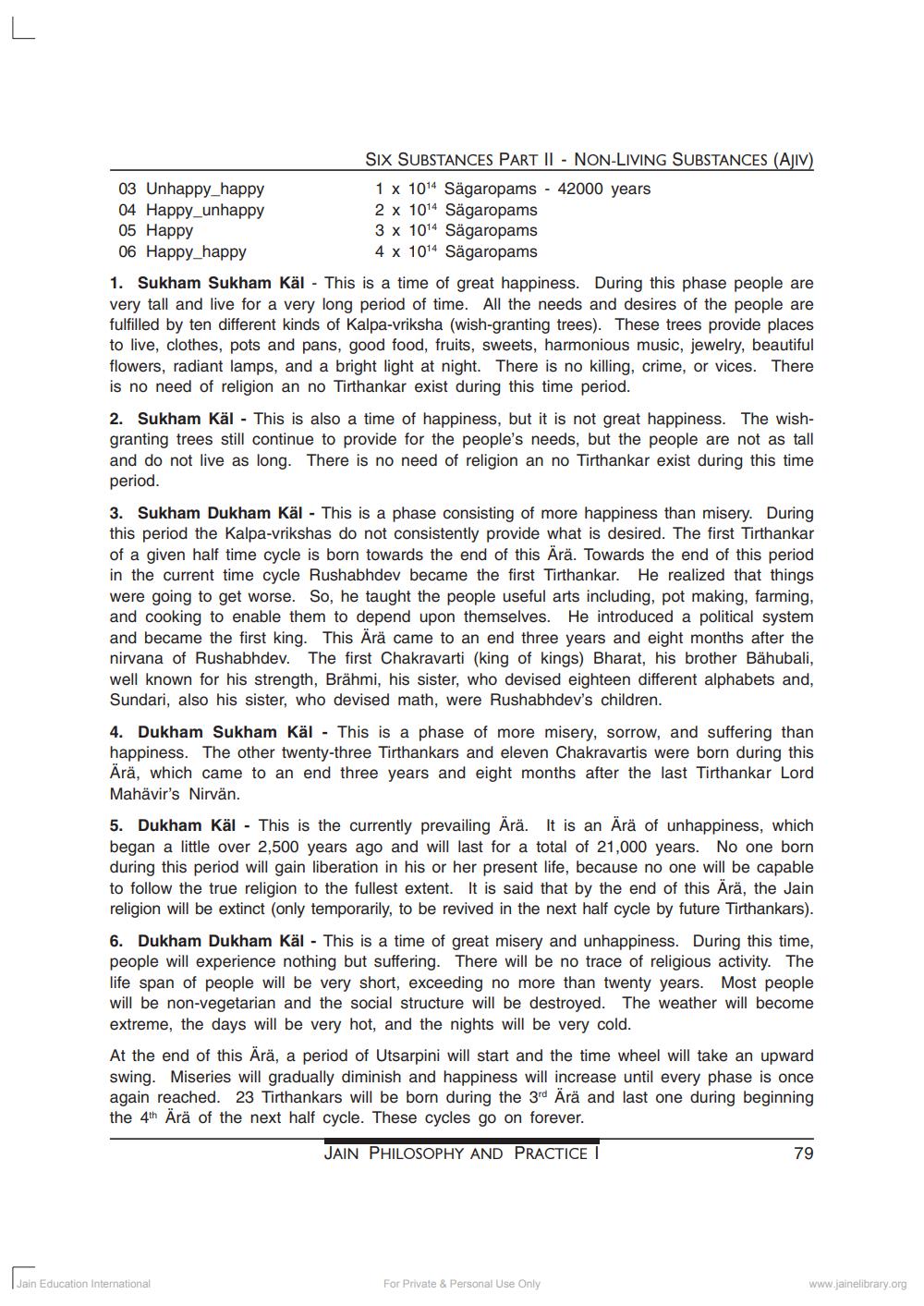________________
SIX SUBSTANCES PART || - NON-LIVING SUBSTANCES (AJIV) 03 Unhappy_happy
1 x 1014 Sägaropams - 42000 years 04 Happy_unhappy
2 x 1014 Sägaropams 05 Happy
3 x 1014 Sägaropams 06 Happy_happy
4 x 1014 Sägaropams 1. Sukham Sukham Käl - This is a time of great happiness. During this phase people are very tall and live for a very long period of time. All the needs and desires of the people are fulfilled by ten different kinds of Kalpa-vriksha (wish-granting trees). These trees provide places to live, clothes, pots and pans, good food, fruits, sweets, harmonious music, jewelry, beautiful flowers, radiant lamps, and a bright light at night. There is no killing, crime, or vices. There is no need of religion an no Tirthankar exist during this time period.
2. Sukham Käl - This is also a time of happiness, but it is not great happiness. The wishgranting trees still continue to provide for the people's needs, but the people are not as tall and do not live as long. There is no need of religion an no Tirthankar exist during this time period.
3. Sukham Dukham Käl - This is a phase consisting of more happiness than misery. During this period the Kalpa-vrikshas do not consistently provide what is desired. The first Tirthankar of a given half time cycle is born towards the end of this Ärä. Towards the end of this period in the current time cycle Rushabhdev became the first Tirthankar. He realized that things were going to get worse. So, he taught the people useful arts including, pot making, farming, and cooking to enable them to depend upon themselves. He introduced a political system and became the first king. This Arä came to an end three years and eight months after the nirvana of Rushabhdev. The first Chakravarti (king of kings) Bharat, his brother Bahubali, well known for his strength, Brähmi, his sister, who devised eighteen different alphabets and, Sundari, also his sister, who devised math, were Rushabhdev's children. 4. Dukham Sukham Käl - This is a phase of more misery, sorrow, and suffering than happiness. The other twenty-three Tirthankars and eleven Chakravartis were born during this Ärä, which came to an end three years and eight months after the last Tirthankar Lord Mahävir's Nirvän.
5. Dukham Käl - This is the currently prevailing Ärä. It is an Ärä of unhappiness, which began a little over 2,500 years ago and will last for a total of 21,000 years. No one born during this period will gain liberation in his or her present life, because no one will be capable to follow the true religion to the fullest extent. It is said that by the end of this Ärä, the Jain religion will be extinct (only temporarily, to be revived in the next half cycle by future Tirthankars). 6. Dukham Dukham Käl - This is a time of great misery and unhappiness. During this time, people will experience nothing but suffering. There will be no trace of religious activity. The life span of people will be very short, exceeding no more than twenty years. Most people will be non-vegetarian and the social structure will be destroyed. The weather will become extreme, the days will be very hot, and the nights will be very cold.
At the end of this Ärä, a period of Utsarpini will start and the time wheel will take an upward swing. Miseries will gradually diminish and happiness will increase until every phase is once again reached. 23 Tirthankars will be born during the 3rd Ärä and last one during beginning the 4th Ärä of the next half cycle. These cycles go on forever.
JAIN PHILOSOPHY AND PRACTICE I
Jain Education International
For Private & Personal Use Only
www.jainelibrary.org




